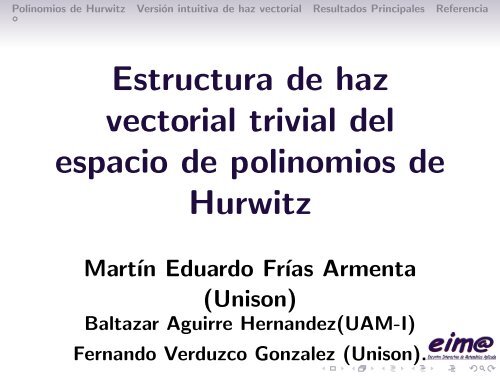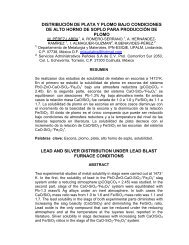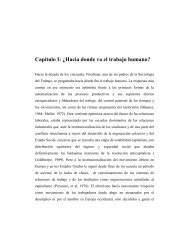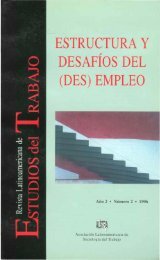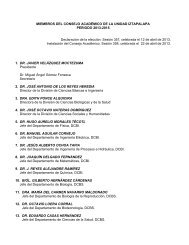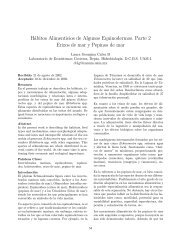Estructura de haz vectorial trivial del espacio de polinomios de Hurwitz
Estructura de haz vectorial trivial del espacio de polinomios de Hurwitz
Estructura de haz vectorial trivial del espacio de polinomios de Hurwitz
You also want an ePaper? Increase the reach of your titles
YUMPU automatically turns print PDFs into web optimized ePapers that Google loves.
Polinomios <strong>de</strong> <strong>Hurwitz</strong> Versión intuitiva <strong>de</strong> <strong>haz</strong> <strong>vectorial</strong> Resultados Principales Referencia<br />
<strong>Estructura</strong> <strong>de</strong> <strong>haz</strong><br />
<strong>vectorial</strong> <strong>trivial</strong> <strong>de</strong>l<br />
<strong>espacio</strong> <strong>de</strong> <strong>polinomios</strong> <strong>de</strong><br />
<strong>Hurwitz</strong><br />
Martín Eduardo Frías Armenta<br />
(Unison)<br />
Baltazar Aguirre Hernan<strong>de</strong>z(UAM-I)<br />
Fernando Verduzco Gonzalez (Unison).
Polinomios <strong>de</strong> <strong>Hurwitz</strong> Versión intuitiva <strong>de</strong> <strong>haz</strong> <strong>vectorial</strong> Resultados Principales Referencia<br />
Contenido<br />
1 Polinomios <strong>de</strong> <strong>Hurwitz</strong><br />
2 Versión intuitiva <strong>de</strong> <strong>haz</strong> <strong>vectorial</strong><br />
3 Resultados Principales<br />
4 Referencia
Polinomios <strong>de</strong> <strong>Hurwitz</strong> Versión intuitiva <strong>de</strong> <strong>haz</strong> <strong>vectorial</strong> Resultados Principales Referencia<br />
Definición<br />
Un polinomio es <strong>Hurwitz</strong> si todas sus<br />
raíces tienen parte real negativa.<br />
Denotaremos por H n<br />
+ el <strong>espacio</strong> <strong>de</strong><br />
<strong>polinomios</strong> <strong>Hurwitz</strong> <strong>de</strong> grado n y<br />
coeficintes positivos
Polinomios <strong>de</strong> <strong>Hurwitz</strong> Versión intuitiva <strong>de</strong> <strong>haz</strong> <strong>vectorial</strong> Resultados Principales Referencia<br />
Propieda<strong>de</strong>s conocidas <strong>de</strong> los<br />
<strong>polinomios</strong> <strong>Hurwitz</strong><br />
1 H + n es abierto.<br />
2 H + n es contraible.
Polinomios <strong>de</strong> <strong>Hurwitz</strong> Versión intuitiva <strong>de</strong> <strong>haz</strong> <strong>vectorial</strong> Resultados Principales Referencia<br />
Versión intuitiva <strong>de</strong> <strong>haz</strong><br />
<strong>vectorial</strong><br />
E y B son varieda<strong>de</strong>s suaves, π : E → B es<br />
una función suave tal que π −1 (u) es<br />
difeomorfo a u × R n para cada abierto u <strong>de</strong><br />
B, entonces diremos E = (E, B, π) es un<br />
<strong>haz</strong> <strong>vectorial</strong> suave <strong>de</strong> rango n con base B.<br />
Y diremos que E es <strong>trivial</strong> si E es difeomorfo<br />
a B × R n
Polinomios <strong>de</strong> <strong>Hurwitz</strong> Versión intuitiva <strong>de</strong> <strong>haz</strong> <strong>vectorial</strong> Resultados Principales Referencia<br />
Figura: 1 :Círculo
Polinomios <strong>de</strong> <strong>Hurwitz</strong> Versión intuitiva <strong>de</strong> <strong>haz</strong> <strong>vectorial</strong> Resultados Principales Referencia<br />
Figura: 2: Cilindro
Polinomios <strong>de</strong> <strong>Hurwitz</strong> Versión intuitiva <strong>de</strong> <strong>haz</strong> <strong>vectorial</strong> Resultados Principales Referencia<br />
Figura: 3: Banda <strong>de</strong> Möbius
Polinomios <strong>de</strong> <strong>Hurwitz</strong> Versión intuitiva <strong>de</strong> <strong>haz</strong> <strong>vectorial</strong> Resultados Principales Referencia<br />
1 H + n es un <strong>haz</strong> <strong>trivial</strong> <strong>de</strong> rango 1 con<br />
base H + n−1<br />
2 H + n es difeomorfo a R n+1
Polinomios <strong>de</strong> <strong>Hurwitz</strong> Versión intuitiva <strong>de</strong> <strong>haz</strong> <strong>vectorial</strong> Resultados Principales Referencia<br />
Test <strong>de</strong> estabilidad<br />
consi<strong>de</strong>remos P(t) ∈ H + n , dado por<br />
P(t) = a n t n + a n−1 t n−1 + · · ·+a 1 t + a 0 , (1)<br />
<strong>de</strong>finimos el polinomio R(t) <strong>de</strong> grado n − 1<br />
como R(t) =<br />
a 2 n−1 tn−1 + (a n−1 a n−2 − a n a n−3 ) t n−2 +<br />
a n−1 a n−3 t n−3 + (a n−1 a n−4 − a n a n−5 ) t n−4 +<br />
· · · .<br />
Theorem<br />
P(t) es <strong>Hurwitz</strong> si y sólo si R(t) es estable
Polinomios <strong>de</strong> <strong>Hurwitz</strong> Versión intuitiva <strong>de</strong> <strong>haz</strong> <strong>vectorial</strong> Resultados Principales Referencia<br />
Referencia<br />
Baltazar Aguirre-Hernan<strong>de</strong>z,<br />
Martín Eduardo Frías Armenta,<br />
Fernando Verduzco<br />
”Smooth <strong>trivial</strong> vector bundle structure of<br />
the space of <strong>Hurwitz</strong> polynomials”<br />
Aceptado en Automatica Ed. Essiver.
Polinomios <strong>de</strong> <strong>Hurwitz</strong> Versión intuitiva <strong>de</strong> <strong>haz</strong> <strong>vectorial</strong> Resultados Principales Referencia<br />
Gracias por su atención.


